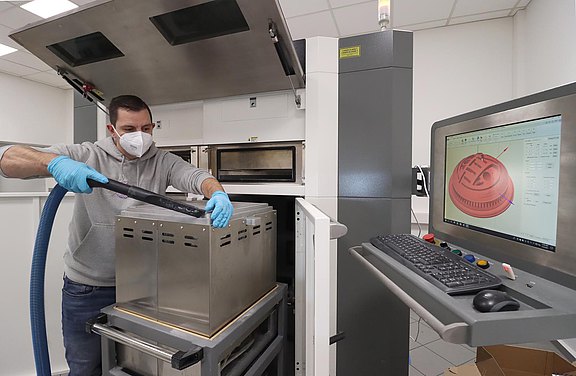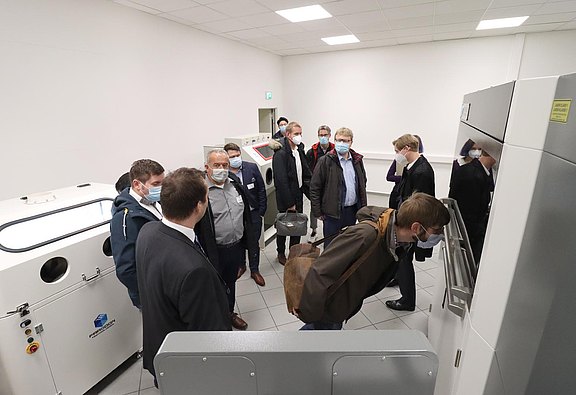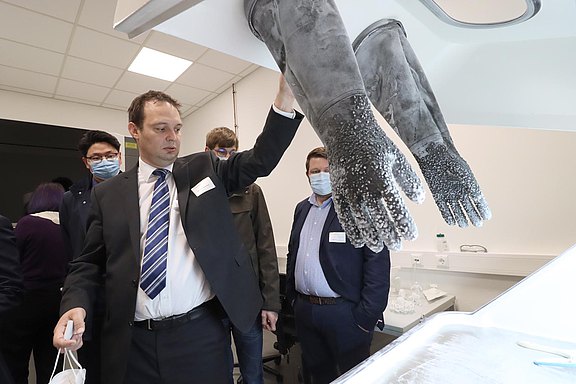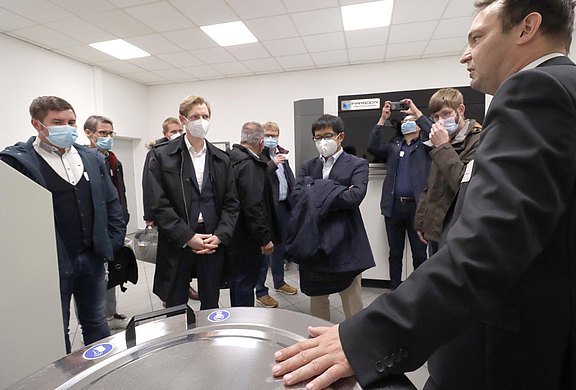The 3D printing competence center Rudolstadt, located at the TITK, has so far only worked with the so-called FDM or FFF process. The abbreviations stand for Fused Deposition Modeling and Fused Filament Fabrication, respectively, and describe the layer-by-layer production of a workpiece from a fusible plastic. This is fed as a continuous filament. "Based on our history and our company's many years of textile expertise, we initially only used and researched filaments for 3D printing," explains Patrick Rhein, head of the Additive Manufacturing research group. "With the selective laser sintering system, it is now possible for us to also use and further develop thermoplastic powders."
In contrast to filament-based 3D printing using FDM or FFF processes, selective laser sintering (SLS) involves applying and heating a bed of powder. Laser beams then fuse or sinter the material with high precision and also layer by layer. Since a new powder bed is applied over it again and again, no additional support materials are needed here that would have to be removed again afterwards. "In addition, the strength of the products is significantly higher; they can absorb tensile forces evenly in all directions," says project engineer Henning Austmann.
In terms of 3D printing, this means that industry standard is completely arrived to TITK, which is not only suitable for prototype development, but also for proving a process capability. The SLS system can produce parts with an edge length of up to 45 centimeters. In addition, more technically relevant materials are processed, such as polypropylene (PP), polyamide (PA) or thermoplastic polyurethanes (TPU), while filament-based printing is mainly known for amorphous materials such as ABS and PLA.
"With the new SLS system, we can now expand our work thematically," says team leader Patrick Rhein. Although the powder printing process generally requires longer preparation, it is ultimately much faster. In addition, the printing center at TITK is an open system, which means that all parameters can be determined and preset. "This gives us every opportunity to develop and test new materials together with partners from industry and science," Rhein is pleased to report. After all, the supply of starting materials for the powder printing process is currently still quite limited. In research collaborations, for example, additives are now to be tested for pulverization processes in order to achieve, for example, higher thermal or electrical conductivity as well as flame protection or improved rigidity in additive manufacturing.
In line with the new technical possibilities at TITK, the workshop on November 4 also compared the advantages and disadvantages of filament-based and powder-based 3D printing. On board this time were renowned machine manufacturers, material suppliers, research institutions as well as users from the industry, who conveyed the latest developments from the industry in eight presentations. In addition to a small in-house exhibition, there was again the chance to take a look at the laboratories and pilot plants of the research institute.
Funding note for the above-mentioned investment at TITK: The project on which these results are based was funded by the Free State of Thuringia and the Thuringian Ministry of Economics, Science and Digital Society (TMWWDG) with state funds under the number 2021 WIN 0010.
Read more about this topic here.



